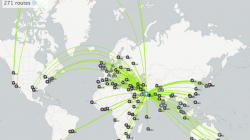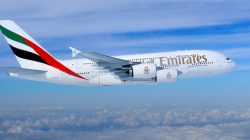Emirates will be increasing its Seattle capacity this summer by adding a second daily nonstop flight between its Dubai hub and the Pacific Northwest. Currently, the carrier operates a single daily 777-300ER flight into SeaTac, a route that has been in operation since March 2012, that arrives into Seattle in the early afternoon and departs for Dubai in the late afternoon. Effective July, Emirates will add a morning departure from Seattle to complement its existing route with an early morning arrival into Seattle and mid morning return to Dubai.
*NEW* Emirates Seattle operation timetable effective July 7, 2015:
EK227 DXB0315 – 0655SEA 77L D *new*
EK229 DXB0935 – 1255SEA 77W D *existing*
EK228 SEA0940 – 1055+1DXB 77L D *new*
EK230 SEA1740 – 1855+1DXB 77W D*existing*
Additional frequency will boost Seattle to second largest EK station in the Americas
Emirates currently serves 9 destinations in the U.S. – Boston, Chicago O’Hare, Dallas/Ft. Worth, Houston, Los Angeles, New York JFK, San Francisco, Seattle and Washington Dulles – in addition to four markets in Canada, Argentina and Brasil: Toronto, Buenos Aires, Rio de Janeiro and Sao Paulo.
Of the aforementioned cities, New York JFK is Emirates’ largest station, which currently sees 3 daily A380 nonstop services to Dubai, as well as a 777-300ER fifth freedom route to Milan, which will soon be up-gauged to an A380 as well. The New York JFK – Milan route has been controversial given that the route is already served by three US and Italian carriers (American, Delta and Alitalia) and that since Emirates has entered the market, fares have plummeted and margins have suffered.
Elsewhere in its US system, Emirates operates Airbus A380 services to Los Angeles, San Francisco, Dallas/Ft. Worth and Houston. All four of these stations were up-guaged to Airbus A380 routes between December 2013 and December 2014 from 777 series aircrafts, presumably amidst increasing competition from Emirates’ primary regional competitors, Etihad, Qatar Airways and Turkish Airlines to these markets. Etihad launched service to Dallas/Ft. Worth, San Francisco and Los Angeles in the past 15 months, and Qatar Airways commenced service to Dallas/Ft. Worth in July 2014.
Once the second daily Emirates route comes online, Seattle will see a 42% jump in seating capacity with roughly 4,400 weekly seats on offer to Dubai. This will effectively rank Seattle as the #2 market in the Western Hemisphere in terms of frequencies and seats, behind New York JFK. Emirates’ four A380 stations are all tied at #3 with approximately 3,521 weekly seats on offer, followed next by Washington Dulles, Boston and Chicago tied at #4 with 2,597 weekly seats, according to CAPA seat data.
Year-round load factors on Emirates’ Seattle route may have improved since startup
Data from CAPA and the Bureau of Transportation Statistics have shown that load factors on Emirates’ route to Seattle have improved since the startup date in March 2012. Typically, the route has tended to perform strongly during the summer months with numbers high into the 90 percentiles between July and September, although during the months of October and November, numbers have fared poorly with load factors dipping into the 50-60 percentiles. Although data is not available for fall 2014 figures, it could be possible that the route has fared better during the slower periods.
Emirates may be taking advantage of soured relationship between Alaska and Delta
Although Emirates does not offer a codeshare agreement with Seattle’s hometown carrier, Alaska Airlines, the two carriers have a mileage accrual and redemption agreement which permits Alaska frequent fliers to use their points to book award space in Emirates cabins. Theoretically, Alaska frequent fliers already have an existing plethora of mileage redemption opportunities via Delta’s long-haul services to London, Paris and Amsterdam from Seattle. However, with the relationship continuing to unravel between Delta and Alaska, coordination between the two frequent flier programs have become much more muddled and SkyTeam is likely bleeding a lot of Alaska VIP members to other carriers.
Additionally, Seattle is home to many fortune 500 companies that send corporate travelers to India and the Middle East. Dubai has a noon to afternoon connecting bank to multiple markets in the subcontinent, as well as a midnight arrival bank that will cater nicely towards passengers traveling between Seattle and India. Moreover, two 777s can increase cargo capacity to carry spare parts between Boeing’s manufacturing
Emirates may also be flexing its muscle to Delta CEO Richard Anderson in Seattle
The Big Three Middle East carriers have been scrutinized in recent weeks against allegations of receiving unfair subsidies from their respective governments, according to a study commissioned by Delta, American and United. Calls to action have been mandated by the CEOs of the major US carriers in requesting that the US Department of Transportation reconsider the Open Skies agreement with Qatar and the United Arab Emirates to limit the growth of the likes of Emirates, Etihad and Qatar.
The spat has evolved to include disparaging remarks between the CEOs of all six carriers, most notably being Delta’s CEO Richard Anderson from the U.S. side of contention. Mr. Anderson made a comment in February 2015 implying that the Gulf carriers were behind the terrorist attacks of 9/11. The responses from the Gulf Carriers were cool, at best, with Emirates President Tim Clark replying that Mr. Anderson should have considered the logic behind his statement in light of SkyTeam’s admission of Saudia Airlines into the alliance several years ago.
It could be possible, then, that in response to these allegations, Emirates is beefing up its presence in Seattle, which coincidentally (or not) has been a major focus for Delta in the past few years. Aside from bolstering its international profile from Seattle, Delta has also been adding domestic and transborder links to create a west coast gateway hub. It is rare for Emirates to add multiple daily frequencies to ultra long-haul markets, with New York being the only exception to this norm given its sheer size. It is worth mentioning that Emirates’ previous attempts to add second frequencies to Los Angeles and Houston in 2011 were short-lived, given that the influx in seats did not justify the costs of operating two long-stage routes to either market.
It remains to be seen whether Seattle can support two daily flights to Dubai over the long run
Given that Seattle is a smaller market than Houston and Los Angeles, its questionable that the market is large enough for two frequencies to Dubai, although perhaps cargo alone may be a justification. Given the historically slow performance during the fall months, Emirates may spool down frequencies in the October/November time frame or reconsider seasonal adjustments.
It is also noteworthy that this has been one of the longer periods during which Emirates has mooted further pursuits in the U.S. than markets already served. Rather than out-maneuver its competitors by expanding into untapped cities, Emirates has been up-sizing its market presence in concentrated regions and attempting to woo premium travelers with its in-flight products such as on-board showers and enclosed suites. Seattle, however, will see an older generation premium product on the additional 77L flight, which again brings into question if the route has a business or political purpose behind it.
Nevertheless, the move on Emirates’ part is an indication that the Gulf Carriers are still going to discover ways to out-maneuver traditional network planning group-think, perhaps further soiling relations with large-scale US carriers and their European joint venture partners. Unless and until the U.S. government sides with the objections raised by the Big 3 U.S. airlines, Mr. Anderson may have to swallow his pride for the time being.


